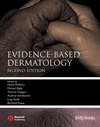|
|
|
| |
 |
|
|

|
 推薦指數:
推薦指數:





|
|
- 內容介紹
|
Evidence-Based Dermatology, 2nd Edition
Hywel Williams (Editor), Michael Bigby (Editor), Thomas Diepgen (Editor), Andrew Herxheimer (Editor), Luigi Naldi (Editor), Berthold Rzany (Editor)
ISBN: 978-1-4051-4518-3
Hardcover
744 pages
Descriptions:
Evidence-based Dermatology, Second Edition is a unique book in the field of clinical dermatology. Written and edited by some of the world’s leading experts in evidence-based dermatology, it takes a highly evidence-based approach to the treatment of all major and many of the less common skin conditions.
The toolbox at the beginning of the book explaining how to critically appraise different studies, along with the comprehensive reviewing and appraisal of evidence in the clinical chapters makes this book distinctive in its field as do the treatment recommendations which are based on the discussion of the best available evidence using a question-driven approach and a common structure on dealing with efficacy, drawbacks and implications for clinical practice.
Contents of the first edition: .
The concept of evidence-based dermatology.
The field and its boundaries.
The rationale for evidence-based dermatology.
The role of the consumer in evidence-based dermatology.
The Cochrane Skin Group.
The critical appraisal toolbox.
Formulating well-built clinical questions.
Finding the best evidence.
The hierarchy of evidence.
How to critically appraise systematic reviews and meta-analyses.
How to assess the evidence for the safety of medical interventions.
How to critically appraise pharmacoeconomic studies.
Applying the evidence back to the patient.
.
The evidence: Common inflammatory skin disease.
Acne vulgaris.
Papulopustular rosacea.
Perioral dermatitis.
Hand eczema.
Atopic eczema.
Seborrhoeic dermatitis.
Psoriasis.
Lichen planus.
Acute urticaria.
.
Skin cancer.
Prevention of skin cancer.
Do sunscreens reduce the incidence of skin cancers?.
Cutaneous melanoma.
Squamous cell carcinoma.
Basal cell carcinoma.
Primary cutaneous T-cell lymphoma.
Actinic keratoses and Bowen's disease.
Kaposi's sarcoma.
.
Infective skin diseases.
Local treatments for cutaneous warts.
Impetigo.
Athlete's foot.
Onychomycosis.
Tinea capitis.
Candidiasis.
Deep fungal infections.
Infestations.
Scabies.
Head lice.
Insect bites.
Vitiligo.
Melasma.
.
Hair Problems.
Male and female androgenetic alopecia.
Alopecia areata.
.
Leg ulceration.
Venous ulcers.
.
Less common skin disorders.
Cutaneous lupus erythematosus.
Dermatomyositis.
Bullous pemphigoid.
Pemphigus.
Cutaneous manifestations of sarcoidosis.
Erythema multiforme.
Stevens-Johnson syndrome and toxic epidermal necrolysis.
Focal hyperhidrosis.
The idiopathic photodermatoses.
The future of evidence-based dermatology.
Where do we go from here?
|
|
|

